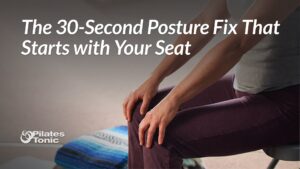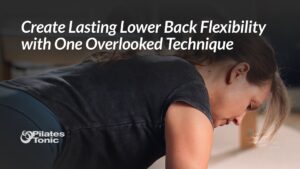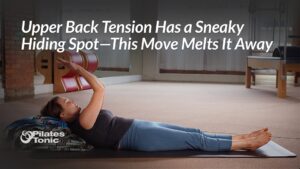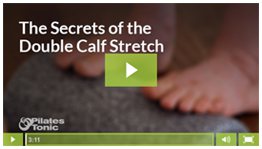Your hamstrings are located at the back of your thigh and are made up of three muscles that attach to the bottom of your pelvis at your ischial tuberosities, or sitting bones, and run down the back of your leg to the top of your lower leg.
The main movements your hamstrings help with are extending your leg behind you, and helping to bend your knee.
On paper, your hamstrings primarily affect only two joints, your hip and knee. However, when the hamstrings become tight and short, they can have a negative effect on your whole body, especially your lower back.
Not only do tight hamstrings make straightening your leg difficult, they also make optimal alignment of your pelvis a problem and sitting on your sitting bones nearly impossible.
In our modern culture, where many of us have tight hip flexors and glute muscles that have gone to sleep, our hamstrings end up working overtime. Overworked hamstrings become tighter and shorter, which makes them more susceptible to injuries.
Today’s video will help you understand the true length of your hamstrings and how they can affect other parts of your body. I'll show you an easy assessment I learned a long time ago and the importance of which was reinforced recently in the Restorative Exercise™ program I'm currently taking. It's an assessment and an exercise that will help lengthen and release tightness that naturally develops over time.
If you try it out, I’d love to hear how it goes in the comments below.
See you in the studio!
Sydney
P.S This is a great exercise to practice in combination with these other stretches:
If You Wear Shoes, You Need This Calf Stretch
The Hip Stretch for Chronic Sitting Syndrome
A Pain-Relieving, Solo Hip Flexor Stretch You’ll Really Love.





14 Responses
Because this video demonstrates the double calf stretch, and follows the one you made demonstrating the single-calf stretch from Katy Bowman’s Restorative Exercise™ program, your readers might be interested in learning more about Katy Bowman and the exercise program she created. I recently completed a certification training week with her in Ventura and found myself among other a few other Pilates instructors. One thing we had in common was a past interest in Rebecca Leone’s work which led us to dig deeper.
Hi Julie, I’m currently going through Katy’s Restorative Exercise™ program and loving it! I was using this video for assessing hamstring length and the next video will be adding Katy’s Double Calf Stretch to the mix. Thanks for your feedback!
Dear Sydney,
All of your videos are informative, enjoyable and make me want to try all exercises immediately.I have tried them all.Happy to report that they work for me. I especially like when a pic of that muscle being stretched is illustrated. I have tight psoas, tight hip flexors causing issues elsewhere. You know what that feels like right? For me, most exercises need to be done daily to allow me to go for my 45 min.walks, my yoga practice and reformer practice.If you lived closer I would be in your studio in 2 sec. flat. Thank you again for your videos, your precise cues, your positive attitude. Love those bloopers. Looking forward to more videos. A suggestion I have would be if the videos could be watched in sequence for easier movement. Maybe a list could be included somewhere on the site. Bye from Canada
Thanks so much for your feedback Aline!
Hi Sydney – all your videos are fantastic and this one is no exception! I particularly like that it’s not ‘just’ a stretch but starts with an assessment of status quo. A really great exercise and I’ll definitely be introducing it to a few students this week! Thanks again! 🙂
Excellent! Thank you Kirsty!
Hi Sydney, just wondering am I meant to feel this in my calves too?
Hi Renee, the calves greatly influence the hamstrings (especially if they are tight!), so it’s completely normal to feel this stretch in the calves too.
Great question!
Hi Sydney!
This exercise is one of the most helpful things ever for me. I use it daily (sometimes several times each day) to release tightness in my lower back. It is ok to do this frequently, yes?
Thanks so much for helping us learn to live well in our bodies!
Hi Anne, You most certainly can practice this one several times a day, especially if you find it relieving for your lower back. I’m thrilled you are finding the videos helpful! It’s always great to hear from you!
Hi Sydney, loving your videos here in Spain. I like the fact you come from a place where you know how many clients feel, having had misalignments yourself.
For stretching the hamstrings, what happens when the tightness is especially in the tendon area of the semimembranosus muscle behind the knee? Are hamstring stretches designed to target and stretch the tendon as well as the muscle? Thanks!
Hi Emma, This is a great question! If your pelvis is neutral and your knees aren’t hyperextended, then it’s completely fine to feel this exercise behind the knees. The soft tissue of your hamstrings and calves merge behind the knee, which is part of why this area is so strongly felt in stretches. Chronic sitting and shoe wearing cause the back of the legs to adapt by literally shortening the soft tissue between the muscle attachment points. This process is called sarcomerolysis. What’s fascinating, is there’s also a process called sarcomerogenesis, where your body grows sarcomeres between muscle attachment points. Which means it’s totally possible to regain lost muscle and soft tissue length when we change the patterns that caused the area to shorten. That’s why the alignment points in stretches are so important. We have to meet our body at our current boundary and ask for length from there. As long as your knees aren’t hyperextended, it’s completely okay to feel hamstring stretches behind your knees. Thanks for your feedback! 🙂
Great video! I was wondering when I do this and hamstring stretches sitting down with a neutral lumbar afterwards my lower back aches where it didn’t before?
I feel like I should know what’s happening but I can’t work it out? If my back is neutral what am I straining?
i’ve been searching the web but I can’t find anything on lower back pain after hamstring stretching, all I can find is tight hamstrings cause low back pain.
Thanks
It sounds like you may be using your lower back muscles to create your neutral. This is a common! Try allowing your lower low back to relax as your tail bone floats up toward the ceiling when you bend forward for this exercise. You could also think of the front of your hips falling toward the floor as your tailbone floats up, and only go as low as you can while easily allowing your lower back to stay relax. Which may mean you don’t go as low and that’s okay! Thanks for your question! Hope this helps and I’d love to hear how it goes!